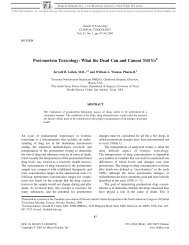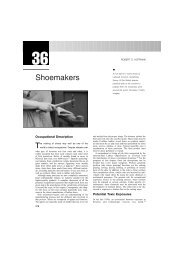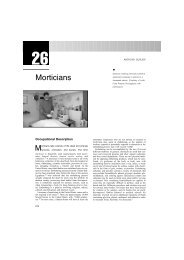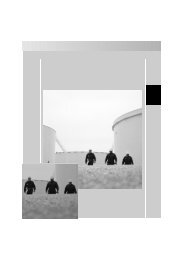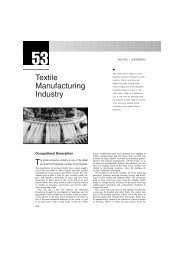9. Treatment of Amatoxin Poisoning-20 year retrospective analysis
9. Treatment of Amatoxin Poisoning-20 year retrospective analysis
9. Treatment of Amatoxin Poisoning-20 year retrospective analysis
You also want an ePaper? Increase the reach of your titles
YUMPU automatically turns print PDFs into web optimized ePapers that Google loves.
738<br />
Age <strong>of</strong> Patient<br />
The age <strong>of</strong> the amatoxin mushroom victim is another<br />
prognostic factor. Fatal outcomes are usually associated<br />
with age less than 10 <strong>year</strong>s. [112,244] In the series <strong>of</strong> <strong>20</strong>5<br />
and 83 patients reported by Floersheim et al., [298] and<br />
Lambert and Larcan, [19] the death rates were 51 and 22%<br />
for children below 10 <strong>year</strong>s and 16.5 and 8.8% for adults,<br />
respectively. The high mortality rate in children is likely<br />
related to the larger dose <strong>of</strong> the toxins per unit <strong>of</strong> body<br />
weight.<br />
Retrospective Liver Transplantation Data<br />
In the absence <strong>of</strong> definitive medical treatment for<br />
amatoxin poisoning, LT has changed the outlook for<br />
severe poisoning and can be the single best option<br />
for selected patients. Since 1985, 32 LTs (31 OLT and 1<br />
APOLT) have been performed for amatoxin mushroom<br />
victims representing 1.5% <strong>of</strong> 2108 intoxicated individuals.<br />
Liver transplant increases the survival rate <strong>of</strong><br />
amatoxin poisoning considering the LT patient was<br />
presumed as a fatal case. Easily applicable criteria are<br />
needed to identify patients for whom transplantation is<br />
indicated. Prognostic indicators such as encephalopathy<br />
stages, coagulation factors, metabolic abnormalities, and<br />
age have to be taken into account in the decision to<br />
perform liver transplant (OLT and APOLT) but do not<br />
replace intensive medical experience. Serious amatoxin<br />
intoxication must no longer be considered only as an<br />
acute disease with massive necrosis whose prognosis<br />
depends only on the early course <strong>of</strong> the poisoning. The<br />
progression <strong>of</strong> severely poisoned cases towards either<br />
massive necrosis or chronic active hepatitis from <strong>20</strong> to<br />
70% [176,177] should be considered factors determining<br />
LT.<br />
Statistical Analysis <strong>of</strong> Retrospective Data<br />
Two general frequency tables were established<br />
including and excluding the LT cases, and composed<br />
for a systematic <strong>analysis</strong>. Statistical comparison <strong>of</strong> the<br />
2 £ 2 tables determined significant differences in the<br />
mortality rates <strong>of</strong> the 11 modes <strong>of</strong> care; the applied<br />
treatments were sorted by increasing efficacy, i.e.,<br />
decreasing mortality rates (MR) combining MRLTi and<br />
MRLTe. Table 8 shows the 11 modes <strong>of</strong> care in order <strong>of</strong><br />
increasing efficacy/decreasing mortality rates from #1 to<br />
#11 and the number <strong>of</strong> cases in each group including and<br />
excluding the liver transplanted patients with the related<br />
mortality rates. Then to further evaluate significant<br />
comparison between the 11 analyzed therapeutic<br />
MARCEL DEKKER, INC. 270 MADISON AVENUE NEW YORK, NY 10016<br />
©<strong>20</strong>02 Marcel Dekker, Inc. All rights reserved. This material may not be used or reproduced in any form without the express written permission <strong>of</strong> Marcel Dekker, Inc.<br />
Enjalbert et al.<br />
modalities (#1 to #11), five pooled therapies from #12<br />
to #16 have made up.<br />
The mortality rates <strong>of</strong> the 10 analyzed specific<br />
therapeutic modes varied from 5.4 to 16.9% (MRLTi)<br />
and from 1.4 to 16.9% (MRLTe) for the <strong>20</strong>62 LTi and<br />
<strong>20</strong>31 LTe amatoxin victims, respectively. Mortality rates<br />
were 47.3% ðNo: ¼ 91 LTiÞ and 43.5% ðNo: ¼ 85 LTeÞ<br />
for amatoxin poisoned patients receiving supportive<br />
measures alone (Fig. 1).<br />
First, the mortality rates <strong>of</strong> supportive measures alone<br />
(#11) were significantly higher than those found for the<br />
group <strong>of</strong> combined 10 specific therapies (#14, detoxication<br />
procedures plus nine chemotherapies) as reported in<br />
Tables 8 and <strong>9.</strong> Then, the MR <strong>of</strong> detoxication procedures<br />
(#5) compared with #13, the nine combined chemotherapies,<br />
were not statistically different, but were significantly<br />
lower than those <strong>of</strong> two chemotherapies:<br />
BpThioca (#1) and BpwSilybTriPoly (#2). More<br />
importantly, the MRLTe <strong>of</strong> detoxication-proceduresalone<br />
(#5) was significantly higher than those <strong>of</strong> silybin<br />
plus benzylpenicillin (#8) and silybin (#10) as monochemotherapy<br />
(<strong>9.</strong>0 vs. 6.0 and 1.4%, respectively).<br />
Finally, the differences between the 9 individual applied<br />
chemotherapies were evaluated. The chemotherapies<br />
exhibiting the highest mortality rates were the combination<br />
<strong>of</strong> benzylpenicillin and thioctic acid (#1.<br />
BpThioca) followed by benzylpenicillin in drug<br />
combinations without silybin as tri- and poly-chemotherapies<br />
(#2. BpwSilybTriPoly), and by the combination<br />
<strong>of</strong> benzylpenicillin and steroids (#3. BpSter).<br />
The chemotherapies with the lowest mortality rates<br />
were silybin as mono-chemotherapy (#10. Silyb) and<br />
silybin plus benzylpenicillin without and with other<br />
drugs (#8. BpSilyb, #<strong>9.</strong> BpSilybTriPoly) and NAC as<br />
mono-chemotherapy (#7. NAC). Both MRLTi and<br />
MRLTe <strong>of</strong> BpThioca (#1), BpwSilybTriPoly (#2), and<br />
BpSter (#3) were not statistically different between them<br />
(Table 9), and were significantly higher than those <strong>of</strong><br />
BpSilyb (#8), BpSilybTriPoly (#9), and Silyb (#10).<br />
Moreover no significant difference was observed<br />
between the MR <strong>of</strong> the four best therapies with the lowest<br />
mortality rates: NAC (#7), BpSilyb (#8), BpSilybTriPoly<br />
(#9), and Silyb (#10). The MR <strong>of</strong> #6, benzylpenicillin<br />
plus one or more antioxidant drug (cimetidine, NAC, or<br />
vitamin C), were significantly lower only than those <strong>of</strong><br />
BpThioca (#1). The MR <strong>of</strong> NAC (#7) were significantly<br />
lower than those <strong>of</strong> both BpThioca (#1) and BpwSilyb-<br />
TriPoly (#2).<br />
On the other hand, the statistical data were not<br />
significant for certain treatment groups whose mortality<br />
rates appear to be different in part due to the disparity <strong>of</strong>




